Physical Address
304 North Cardinal St.
Dorchester Center, MA 02124
Endoscopic therapy and radiologic treatment of biliary disease have evolved in separate but parallel manners. Endoscopic therapy is performed using ERCP and EUS-guided techniques. ERCP is performed primarily by endoscopists trained in a gastroenterology fellowship program, but in some centers it is performed by surgeons. ERCP is one of the most technically demanding endoscopic procedures, and for the successful management of complex cases the learning curve is steep. EUS-guided therapies are done almost exclusively by gastroenterology-trained endoscopists and have seen an expansion in utility as new indications for their use have been demonstrated. Radiologic therapy of the biliary tract is performed via a percutaneous approach by interventional radiologists. The 3 approaches should be seen as complementary rather than competitive. The decision to proceed with an endoscopic or radiologic approach is often based on local expertise; other considerations include physician referral patterns, the location of a lesion within the biliary tract, failure of one method, and altered anatomy as a result of prior surgery.
Imaging of the biliary tract is of utmost importance in planning the management approach to patients with biliary disorders, regardless of whether an endoscopic or percutaneous approach is taken, and is discussed briefly in this context.
Noninvasive imaging of the biliary tract frequently begins with transabdominal US, which provides a global picture of the liver and is nearly universally available. There is no radiation exposure, and contrast agents are not required. Intrahepatic ductal dilatation can be visualized easily, and the size of the bile duct can be documented. US also provides imaging of the gallbladder and detects gallstones (see Chapter 65 ). For detection of choledocholithiasis, US has a high specificity, but the sensitivity does not exceed 68% and is often lower than 50%. The sensitivity decreases if the stones are small and the bile ducts are not dilated. US is highly accurate (78% to 98%) for detecting extrahepatic biliary obstruction; however, the pretest probability of choledocholithiasis greatly affects the utility of the test. When used in conjunction with clinical and laboratory evaluation, US allows differentiation between liver parenchymal disease and extrahepatic biliary obstruction with a reasonable sensitivity and high specificity (see Chapter 21 ). US is less accurate, however, at defining the level and cause of obstruction, with accuracy rates ranging from 27% to 95% and 23% to 88%, respectively. In addition, US is limited in the ability to distinguish malignant from benign causes of obstruction. These limitations may be pronounced in obese patients due to the increased distance the ultrasound wave must travel, thereby reducing the resolution and depth of the image. Advances in US have included 3- and 4-dimensional imaging, use of contrast agents, and elastography (see Chapter 74 ).
MRCP is an MRI study (and thus noninvasive) that is dependent on the high T2-signal characteristics of bile, which produce a high-intensity bright signal on the resulting image. Solid material such as choledocholithiasis will appear as well-defined, dark filling defects within the bile duct. MRI does not require administration of oral or IV contrast material. For the detection of choledocholithiasis, MRCP has a sensitivity ranging from 81% to 100%, a specificity ranging from 96% to 100%, and high overall diagnostic accuracy ( Fig. 70.1 ). False-positive results may arise from pneumobilia. In addition, MRCP is highly accurate in demonstrating the presence of benign and malignant strictures and allows a thorough evaluation of the intrahepatic bile ducts. In patients suspected of having biliary complications after LT (see Chapter 97 ), IV administration of mangafodipir trisodium (Teslascan, Amersham Health, Princeton, NJ) may be used. This agent is excreted primarily in the bile and may improve imaging sensitivity for post–liver transplant biliary leaks and strictures. In addition, MRI can be performed with an IV contrast agent, such as gadodiamide (Omniscan, GE Healthcare, UK) or gadopentetate dimeglumine (Magnevist, Bayer Healthcare, Leverkusen, Germany or MultiHance, Bracco, Princeton, NJ), to detect and characterize mass lesions in the liver, porta hepatis, or pancreas. Contraindications to MRI include a cardiac pacemaker, an automatic implantable cardioverter defibrillator, and some types of cerebral aneurysm clips. A particular concern about gadolinium-based IV contrast agents is that they may precipitate nephrogenic systemic fibrosis, a rare scleroderma-like disease manifested by hardening of the skin and fibrotic changes that affect multiple organs. The cause remains unclear, but reports suggest that patients with preexisting kidney disease (renal failure) are at greatest risk. Avoiding gadolinium and using lower doses in patients with renal insufficiency reduce the risk.
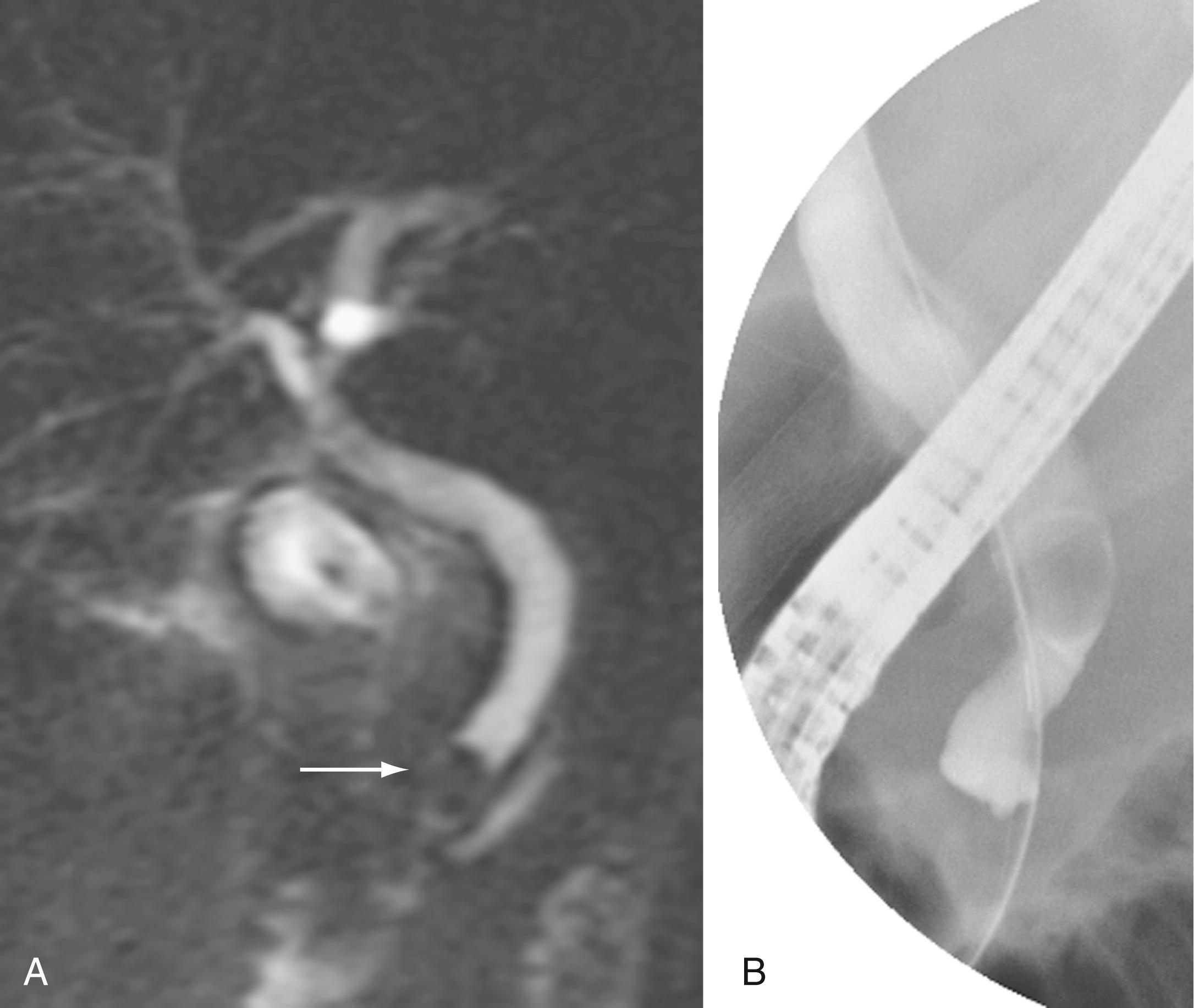
Multidetector CT cholangiography (MDCT) with multiplanar reformation is a CT-based imaging study. MDCT combines rapid-volume acquisition and thin-slice imaging. Water is used as an oral contrast agent for the biliary tract, and IV iodinated contrast is also administered. Images acquired in the axial plane can be reconstructed sagittally or coronally and reformatted 3 dimensionally. The IV contrast dye is not excreted in bile but enhances adjacent surrounding visceral structures such as the liver, pancreas, and other soft tissues. Bile ducts thus appear as low-attenuation structures that are best visualized if dilated. Following surgical resection of malignant tumors involving the liver and bile ducts, MDCT is preferred over MRCP due to a high spatial resolution and ability to demonstrate small anastomotic tumor recurrences. The sensitivity and specificity of MDCT for bile duct strictures are 85.7% and 100%, respectively. MDCT also has a high sensitivity and specificity for the detection of bile duct stones, although diagnostic accuracy decreases considerably when calculi are small or similar in intensity to bile. MDCT has the disadvantage of exposing the patient to the potentially harmful effects of ionizing radiation and contrast injection.
Diagnostic EUS uses an echoendoscope which has an ultrasound transducer located at its tip and emits high-frequency acoustic waves to the surrounding tissues. Either a radial scanning EUS or a linear array EUS is used depending on the images desired and the potential for needle aspiration and biopsy. EUS examination of the biliary tract can be performed by a transgastric or transduodenal approach. Aside from extrapancreaticobiliary structures, the transgastric approach provides images of the pancreatic neck, body, and tail, as well as the gallbladder and left intrahepatic ducts, whereas the transduodenal approach allows imaging of the pancreatic head, gallbladder, ampulla, and bile duct. On EUS, choledocholithiasis demonstrates hyperechoic foci with acoustic shadowing ( Fig. 70.2 ). EUS has a sensitivity and specificity of 95% and 97%, respectively, for the detection of choledocholithiasis and is highly accurate for determining the cause of extrahepatic biliary obstruction, with a sensitivity of 97% and a specificity of 88%. EUS has the ability to distinguish different causes of malignant obstruction. In particular, EUS is more sensitive (93% to 100%) than CT (5% to 77%), transabdominal US (50% to 67%), MRI (50% to 67%), and ERCP (90%) for the detection of pancreatic tumors (see Chapters 60 and 61 ). EUS is less invasive than ERCP and has no associated radiation or contrast exposure. EUS combined with FNA permits tissue diagnosis of masses and lymph nodes. EUS may be preferred over MRCP in some patients, particularly those with contraindications to MRI, and morbid obesity. MRCP may be favored over EUS in patients with altered surgical anatomy, particularly Roux-en-Y and Billroth II anatomy where the endoscope cannot be advanced to the area of interest to provide images. In patients with symptomatic cholelithiasis and an intermediate probability of choledocholithiasis, both EUS and MRCP are acceptable preoperative imaging modalities.
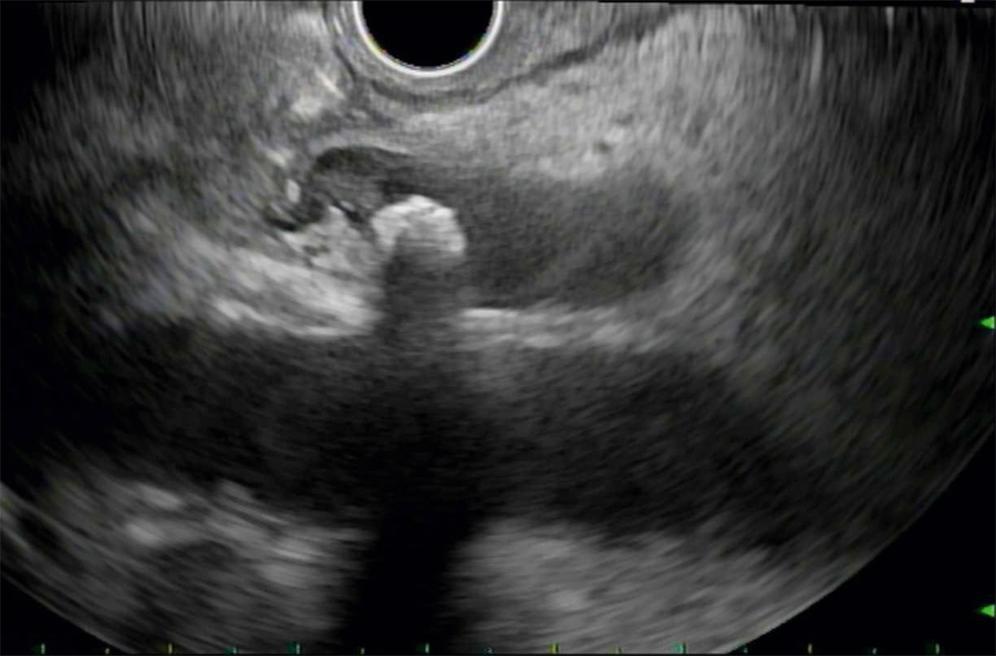
ERCP has evolved from a purely diagnostic to an almost exclusively therapeutic procedure. ERCP is commonly performed using moderate sedation, although in most centers in the USA it is carried out with anesthesia support, especially in more severely ill patients and in cases anticipated to be complex. Patients who receive propofol-based anesthesia for ERCP may have a faster recovery time than those who receive other forms of general anesthesia. ERCP is performed with a side-viewing duodenoscope that allows identification of the major papilla. The bile duct is cannulated under endoscopic and fluoroscopic guidance. A variety of catheters, guidewires, and stents are available to allow therapeutic interventions to be performed. Diagnostic ERCP is now considered obsolete and reserved for facilitating manometry in patients with suspected SOD (see Chapter 63 ) and in those with a possible diagnosis of PSC when other imaging techniques are nondiagnostic (see Chapter 68 ).
In tertiary centers EUS-guided biliary drainage (EUS-BD) has increasingly become an alternative method of biliary decompression in patients who fail standard ERCP or in whom ERCP is not possible, as may occur because of surgically altered anatomy, gastric outlet obstruction, periampullary diverticulum, or inability to advance a guidewire beyond the biliary obstruction. Although percutaneous transhepatic biliary drainage has conventionally been performed in cases of failed ERCP, it is associated with high morbidity and reduced quality of life (see later). The most common approaches to EUS-BD are a transgastric approach to the intrahepatic biliary system and a transduodenal approach to the extrahepatic biliary system. The therapeutic procedures include EUS-guided choledochoduodenostomy (EUS-CD), EUS-guided cholecystoduodenostomy, EUS-guided hepaticoenterostomy (EUS-HE), and EUS-guided rendezvous (EUS-RV) and require technical proficiency in both EUS and ERCP.
EUS-CD consists of transduodenal puncture of the extrahepatic bile duct with an FNA needle under EUS guidance, followed by advancement of a guidewire into the biliary tract, dilation of the tract, and placement of a stent with the proximal portion in the first part of the duodenum. Various biliary access and fistula dilation methods have been described, and the choice of each depends on institutional and endoscopist preferences. One meta-analysis of EUS-CD found a technical success rate of 94% and an early adverse event (AE) (complication) rate of 19%. Self-expandable metal stents are typically preferred over plastic stents because of prevention of bile leaks and increased durability and patency.
EUS-guided cholecystoduodenostomy is used for both primary gallbladder drainage in patients unfit to undergo cholecystectomy and secondary gallbladder drainage to allow removal of a previously placed, temporary percutaneous cholecystostomy tube ( ). The procedure consists of FNA puncture of the gallbladder neck through the wall of the duodenum followed by guidewire placement into the gallbladder. Typically, lumen-apposing metal stents are used to create an anastomosis between the organs, with a decreased risk for stent migration ( Fig. 70.3 ). A plastic pig tail stent is often placed within the metal stent to prevent stent occlusion.
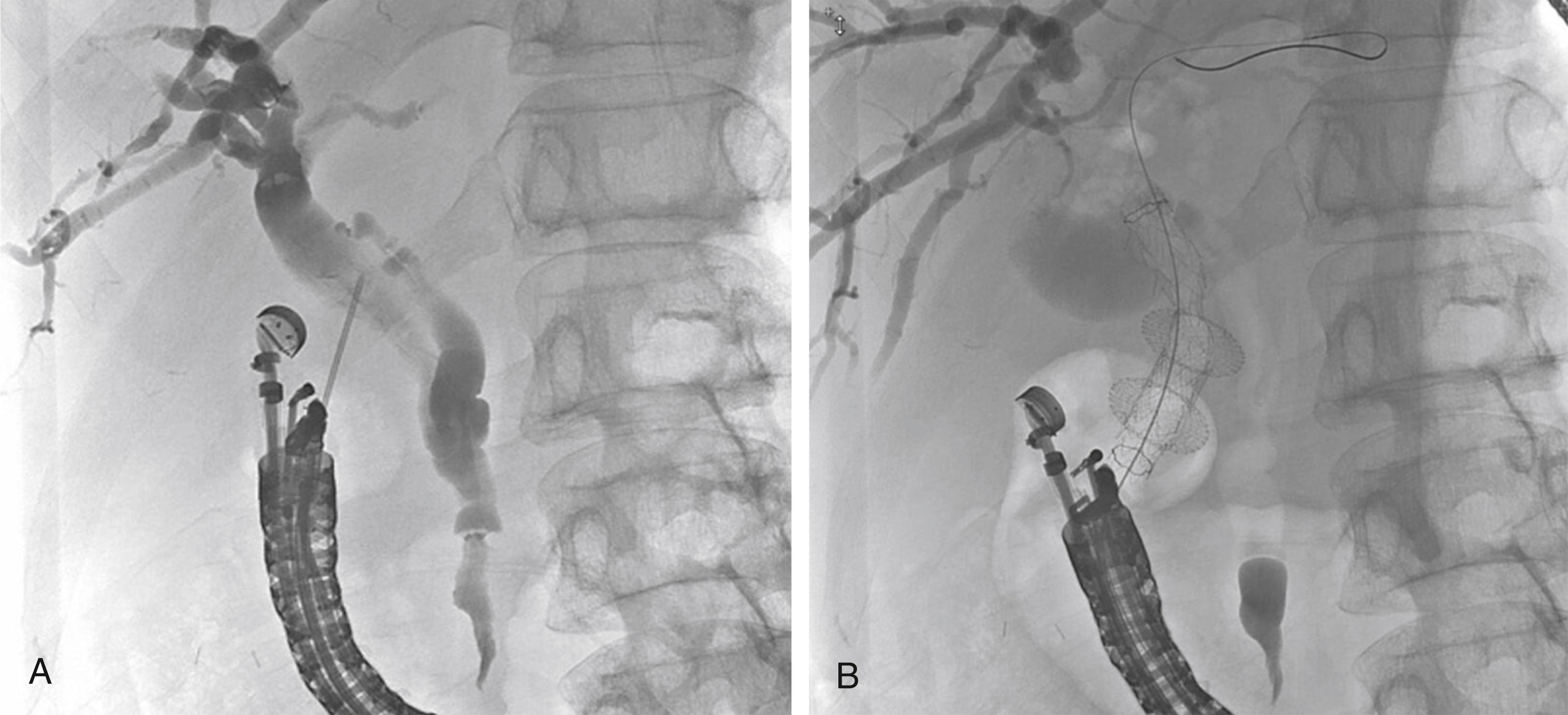
EUS-HE consists of transgastric or transjejunal (in the case of surgically altered anatomy) FNA puncture of a branch of the left intrahepatic bile duct followed by advancement of a guidewire into the biliary system and stent placement ( Fig. 70.4 ). Color Doppler is used to detect interposing vessels so that these may be avoided, and biliary puncture is confirmed by aspirating bile and/or injection of contrast to perform cholangiography. EUS-HE can be used as definitive therapy, as in palliation of malignant biliary obstruction, for preoperative decompression, or as a portal for downstream therapy, including antegrade stent placement.
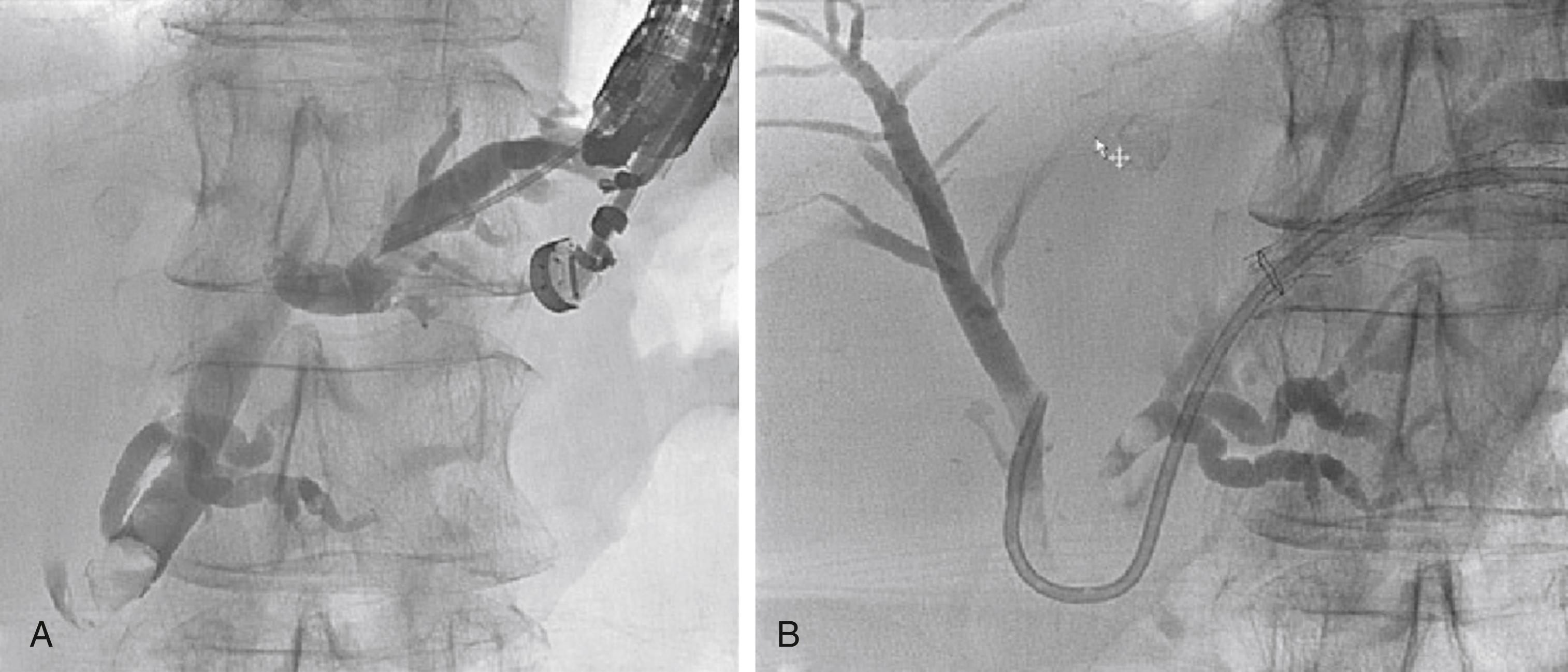
EUS-RV is used in cases of failed ERCP as a means to aid cannulation and/or guidewire placement on a repeat attempt at ERCP. The procedure consists of EUS-guided puncture of the biliary system from either the stomach or duodenum followed by a cholangiogram and guidewire placement into the biliary system. The guidewire is advanced beyond the ampulla and into the duodenum. Following fluoroscopic confirmation of guidewire placement, the echoendoscope and needle are removed, while the guidewire position is maintained. One of 2 approaches can next be performed. In the first, a duodenoscope is inserted alongside the guidewire and advanced to the ampulla, where the guidewire is found and used to assist in cannulation. Alternatively, the distal end of the guidewire can be grasped using a forceps or snare and withdrawn through the mouth, either through the accessory channel or along with the endoscope; a duodenoscope can then be back-loaded over the guidewire and advanced to the ampulla. By either method, the ultimate aim is to endoscopically provide relief of obstruction. The technique is most useful for enabling biliary cannulation and stone removal in patients with a large periampullary diverticulum.
The choice of EUS-BD modality depends on both patient and provider characteristics and is often determined by the preference of the endoscopist. It has been proposed that EUS-RV should be initially attempted if the ampulla is accessible, followed by EUS-CD or EUS-HE as a salvage procedure if the guidewire cannot be advanced to the desired location. EUS-CD or EUS-HE may be attempted initially if the ampulla is inaccessible. Both strategies appear to be equally effective and safe in patients with failed ERCP. A growing body of evidence suggests that EUS-BD may be equivalent to ERCP as a primary therapy for malignant biliary obstruction when performed by an endoscopist with experience in both modalities.
ERCP is usually performed in patients with known choledocholithiasis or in those with at least a moderate clinical suspicion of choledocholithiasis (see Chapter 65 ). In patients with gallbladder stones and a low clinical suspicion of choledocholithiasis, a noninvasive imaging study (MRCP, MDCT) or EUS is preferred to minimize the potential for complications of ERCP. In patients with a low clinical suspicion of choledocholithiasis in whom cholecystectomy is planned, intraoperative cholangiography can be performed, and, if stones are identified, laparoscopic exploration and stone removal can be undertaken. ERCP can then be reserved for patients in whom the stones are not extracted.
The standard method for stone removal is endoscopic biliary sphincterotomy to allow enlargement of the papilla and subsequent extraction of stones with a balloon or basket ( Fig. 70.5 ). With this approach, more than 80% of all stones can be removed successfully. Larger stones may require additional removal techniques (discussed later). Precut sphincterotomy, whereby an incision is made on the papilla prior to cannulation and/or wire guidance, may be used in cases in which cannulation by conventional means has failed and is not associated with an increased risk of AEs when performed by a skilled endoscopist.
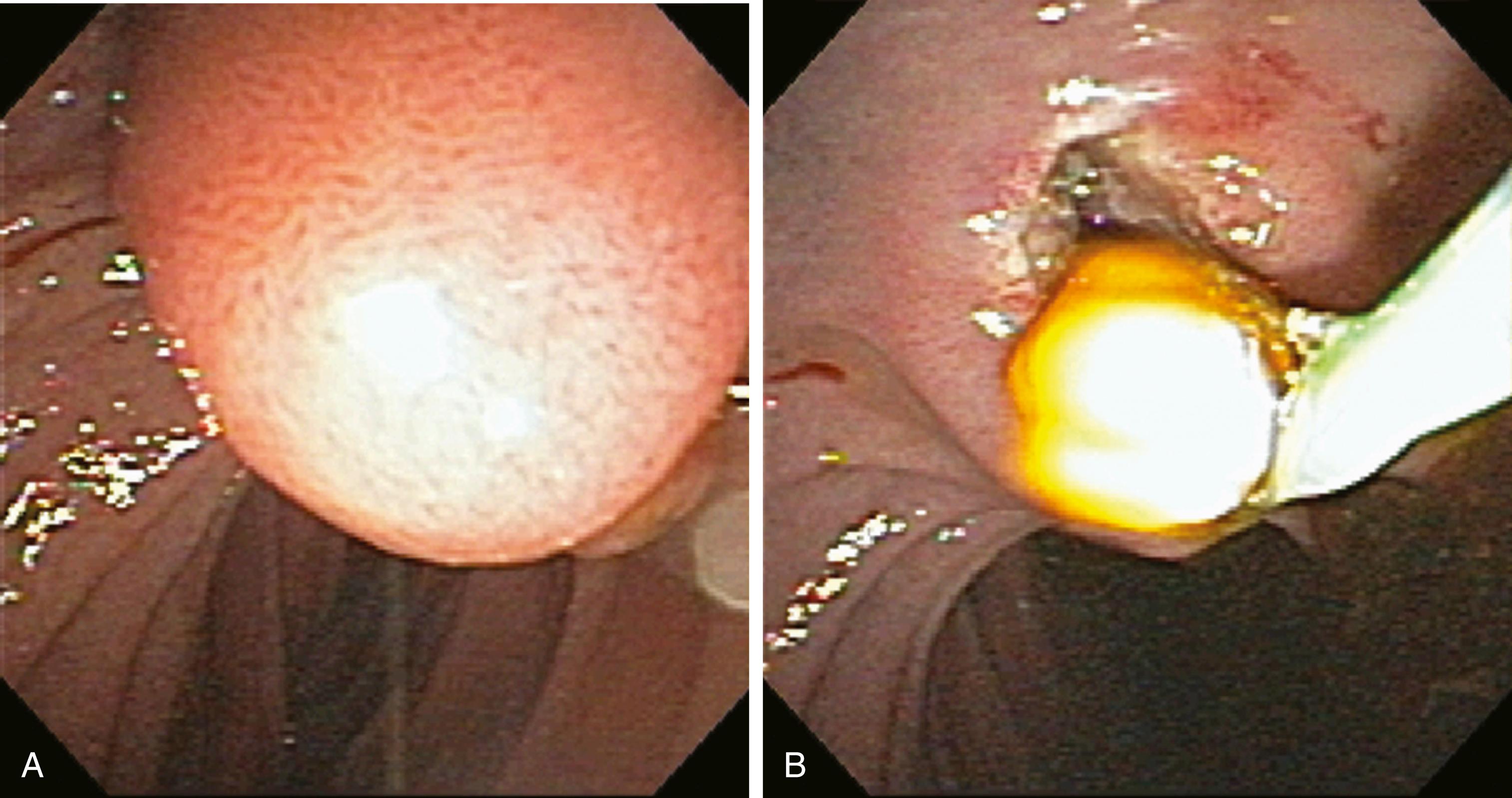
An alternative to biliary sphincterotomy is balloon dilation of the papilla (balloon sphincteroplasty), which can be performed using small-diameter balloons (4 to 8 mm). The technique was introduced as a way to preserve sphincter of Oddi function, especially in young patients. The stones are removed using balloon or basket techniques. Most of the literature on balloon sphincteroplasty comes from outside the USA. Two meta-analyses of randomized trials of balloon sphincteroplasty versus sphincterotomy have shown that the rates of pancreatitis and need for mechanical lithotripsy are significantly higher, but the risk of bleeding is significantly lower, with balloon sphincteroplasty than with sphincterotomy. In the USA, the only randomized trial that compared balloon sphincteroplasty and sphincterotomy was closed prematurely because of 2 deaths in young patients from post-ERCP pancreatitis after sphincteroplasty. Sphincteroplasty still remains, however, an alternative approach in patients with coagulopathy, persons with underlying cirrhosis (particularly Child-Pugh class C [see Chapters 74 and 92 Chapter 74Chapter 92]), and those with altered anatomy (e.g., Billroth II gastrojejunostomy [see Chapter 53 ]), in which sphincterotomy is technically difficult. Measures to reduce the risk of pancreatitis such as prophylactic placement of a pancreatic stent and administration of rectal indomethacin should be used in such cases.
Removal of large bile duct stones (defined arbitrarily as ≥1.5 cm in diameter) may require techniques in addition to those described earlier to be removed successfully. One such technique is lithotripsy. One form of lithotripsy is mechanical lithotripsy, in which the stone is captured in a specialized large basket and crushed ( Fig. 70.6 ). The fragments are removed using standard extraction techniques. Another form of lithotripsy is intraductal lithotripsy, which is performed by fragmenting stones under direct cholangioscopic visualization using a laser or electrohydraulic catheter. Direct visualization is necessary to ensure the lithotripsy device is directed at the stone and not the bile duct wall. The combination of biliary sphincterotomy and large-diameter (12 to 20 mm) balloon dilation has been used to remove large stones and decrease the need for mechanical lithotripsy ( ). This large-diameter dilation method appears to be safe and not associated with an increased risk of post-ERCP pancreatitis. If large stones cannot be removed, a biliary stent is placed to relieve the obstruction ( ). Additional procedures can then be undertaken electively to remove residual stones.
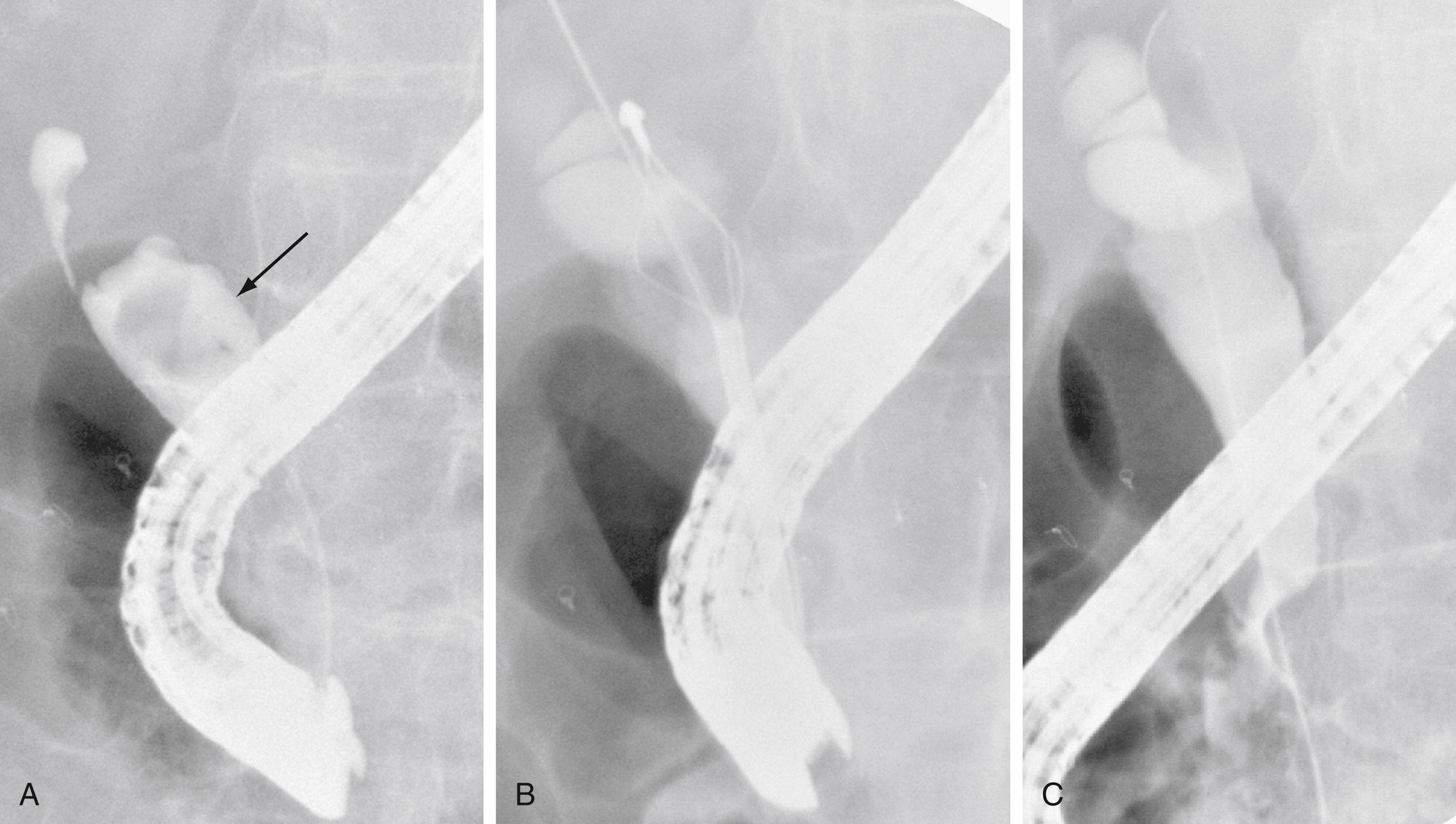
As discussed previously, bile leaks arise as a result of postsurgical complications and trauma. Laparoscopic cholecystectomy carries an incidence rate of bile duct injury from 0.06% to 0.3%. Most commonly, postcholecystectomy leaks arise from either the cystic duct or duct of Luschka (see Chapter 62 ). These smaller leaks can usually be managed with biliary sphincterotomy alone, placement of a plastic biliary stent (7 to 10 Fr), or both. This approach diverts bile away from the leak into the duodenum and negates the effect of the otherwise high-pressure biliary sphincter. More complex leaks usually require placement of one or more large-caliber plastic biliary stents in combination with biliary sphincterotomy ( Fig. 70.7 ). The use of a removable, covered self-expanding metal stent (SEMS) for treatment of refractory leaks has also shown clinical utility.
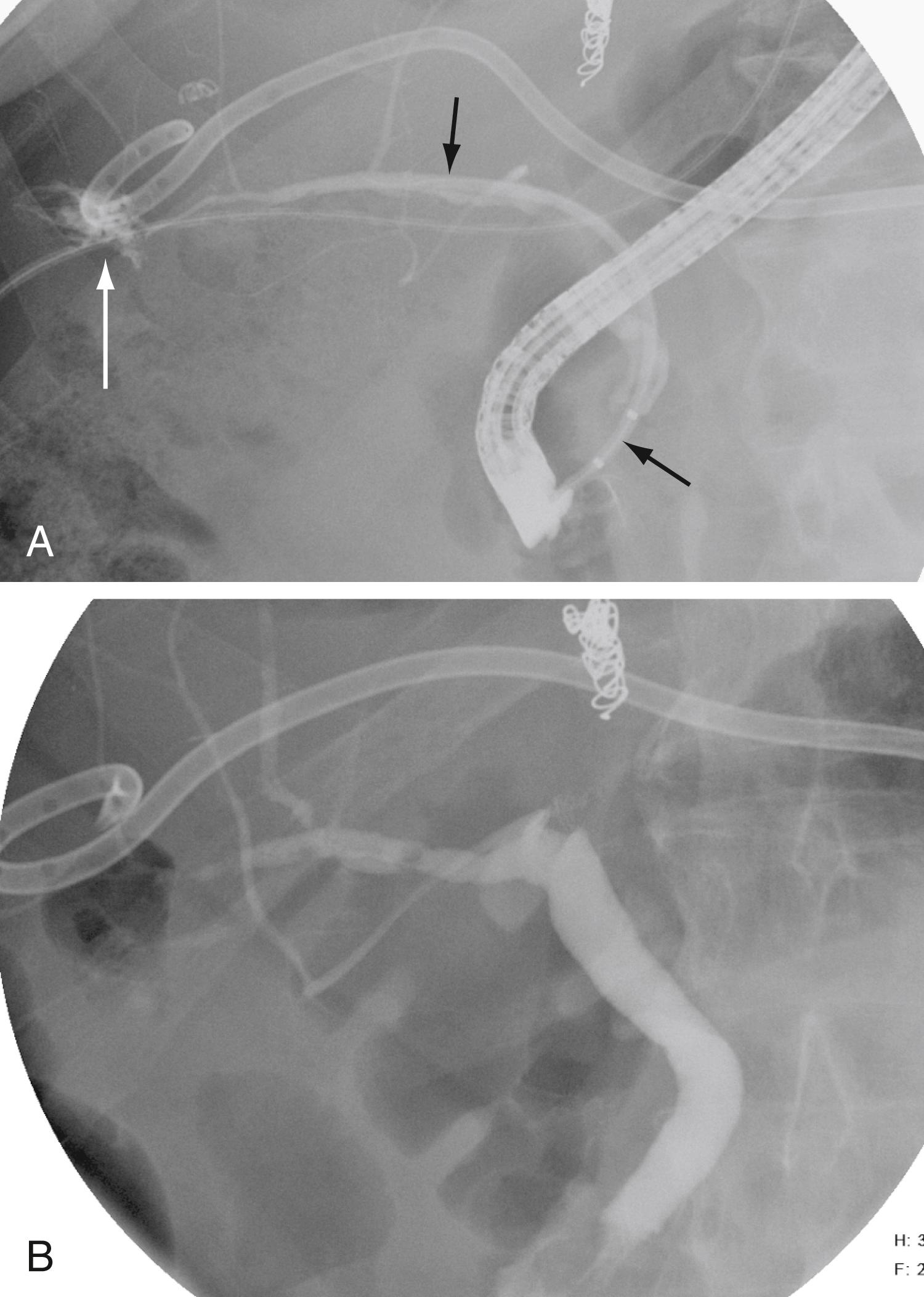
Become a Clinical Tree membership for Full access and enjoy Unlimited articles
If you are a member. Log in here